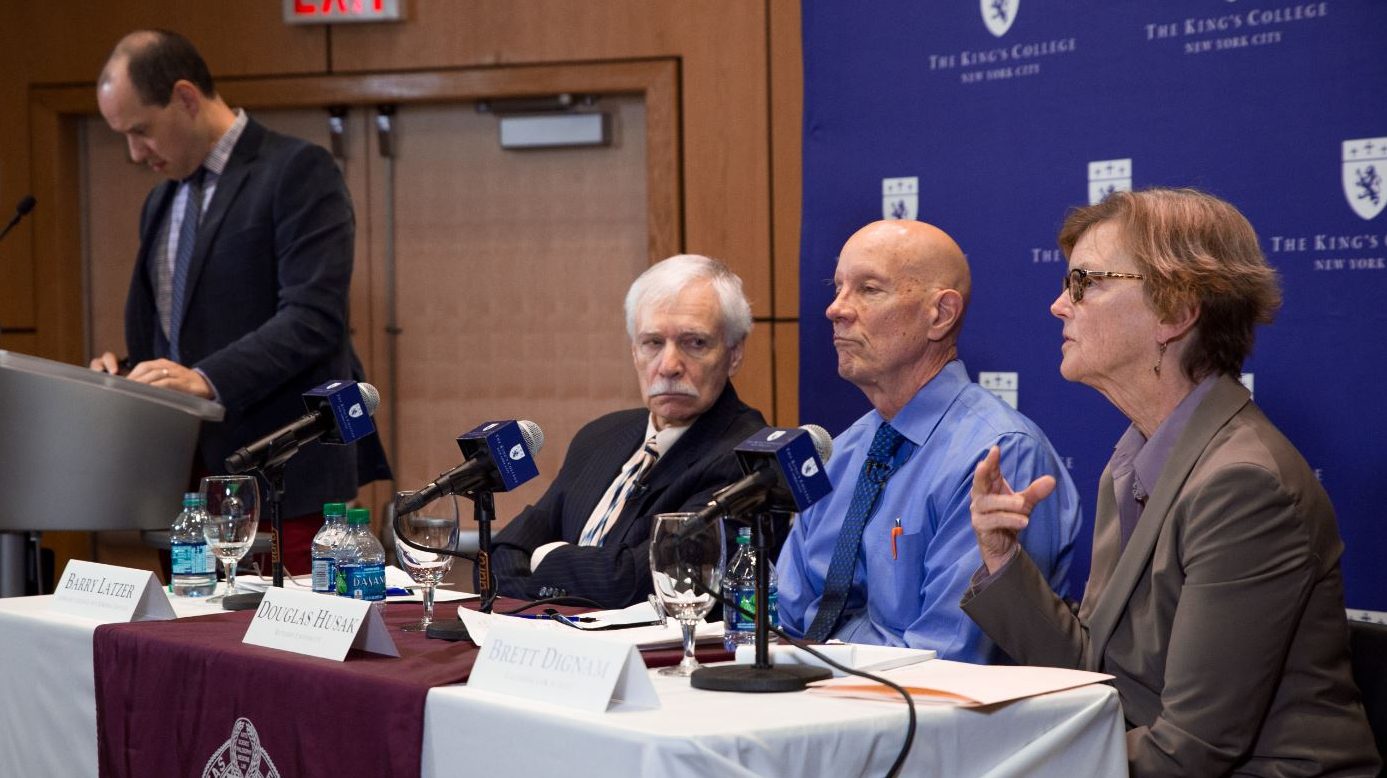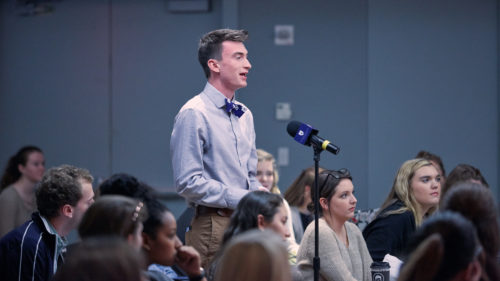Mass Incarceration and Violence: Are We Overpunishing Violent Offenders?
On October 12, the Center for Human Flourishing at The King’s College hosted an interdisciplinary panel discussion on “Mass Incarceration and Violence: Are We Overpunishing Violent Offenders?”

On October 12 at Fordham University’s Lincoln Center campus, the Center for Human Flourishing at The King’s College hosted an interdisciplinary panel discussion on “Mass Incarceration and Violence: Are We Overpunishing Violent Offenders?” The panel featured Dr. Barry Latzer, emeritus professor of criminal justice at John Jay College of Criminal Justice, CUNY; Dr. Douglas Husak, distinguished professor of philosophy at Rutgers University; and Brett Dignam, clinical professor of law at Columbia Law School.
After a reception, the event began with a greeting from Dr. Celia B. Fisher, director of the Center for Ethics Education at Fordham. Fisher framed this discussion as an important continuation of the topics engaged at the Center for Ethics Education’s 2013 Annual Conference, “Jailing for Dollars: Moral Costs of Privatizing Justice.”
Dr. Anthony Bradley, associate professor of religious studies and director of the Center for the Study of Human Flourishing at King’s, then delivered an introduction. The mission of the Center, he said, is to “critically examine and promote the moral, social, political, economic, and aesthetic practices that lead to human flourishing and advance the common good.” These aims borrow from the interdisciplinary focus of Fordham’s Center for Ethics Education, where he earned a Master’s in Ethics and Society. Following last year’s panel discussion at the Princeton Club, this conversation presents multiple perspectives in order to shed light on the approximately 53% of state prisoners incarcerated for acts of violence.
As the first panelist, Latzer drew a definition of violent offense from the four categories recognized by the FBI Uniform Crime Reports: homicide (including murder and manslaughter), rape, robbery, and assault. To determine if America’s prison system is overpunishing violent offenders, he presented data on the current and past severity of punishment, and compared the United States’ punitiveness with that of other countries. In recent years (1994-2012), even as overall crime in the U.S. has gone down, the average length of time served for murder and manslaughter has soared, from 59 months in the 1970-1993 range to 103.9 months in the recent past. Time served for rape has also increased, while the length of time served for robbery and assault has remained relatively stable.1
From 1980-1999, the average time served for all four categories of violent crime in the United States was almost, and in some cases more than, double that of the average of seven other countries (Australia, Canada, Scotland, England and Wales, Sweden, Switzerland, and the Netherlands).2 “This suggests that we give higher punishments,” Latzer concluded, but he offered several caveats. The cross-national data is only available through 1999, and the data on time served in the United States does not account for gun use or the higher sentences given to repeat offenders.
Next Husak, whose speciality is philosophy of criminal law, gave two approaches to evaluate the appropriateness of punishment. In the non-instrumentalist view, punishment ought to be fair and just, measured by the principle of proportionality. By this approach, the severity of punishment should be a function of the seriousness of the crime. “It’s assumed that violence is somehow ‘other than,’” Husak said, but a robust theory of crime seriousness might challenge that presumption.
Getting the principles of proportionality right is difficult and costly. Husak also proposed an instrumentalist approach which sets objectives of punishment and then uses those objectives to tell if sentences are over-punitive. Crime deterrence is a commonly-cited objective, but a more subtle one is imposition of stigma and condemnation. Husak cited the case of Bill Cosby, where many have called for him to be punished, not to deter future sexual misconduct but to publicly censure his behavior. “There are alternative modes of punishment that would allow us to incarcerate less, but it’s really hard to find alternatives to incarceration that stigmatize to the same degree,” Husak said. Husak finally offered his own rule of thumb: “When in doubt, don’t punish.”
Dignam’s experience as a professor of clinical law and litigator for parole applicants gives her a view into “the tail end of the criminal justice system.” Dignam contrasted the “system of barter and contract, accusation, denial, negotiation, and deals” that makes up the criminal process with the emphasis on remorse, restitution, and rehabilitation that characterizes the parole process. “Parole release is meant to be a mechanism to recognize that mistakes do not define a person forever,” Dignam said.
Prisoners typically become eligible for parole release only after decades of incarceration, however. To meet the “acceptance of responsibility” criterion, applicants must demonstrate knowledge of details that they may have long forgotten and that are retained in documents they have never seen. Because of the parole board’s intense caseload, parole officers are often unable to travel to prisons and the fifteen-minute interviews take place on a small tv screen. Application documents that prisoners have painstakingly compiled will receive only cursory attention. “It is extremely difficult to understand decades of a human’s life in a few minutes.”
Dr. Bryan Pilkington, director of academic programs at the Center for Ethics Education at Fordham University, moderated the Q&A. Questions broached issues of racial and gender disparities in incarceration, restorative versus retributive justice, and appropriate punishments for juveniles. The event concluded with a dessert reception, where lively conversation between student and faculty audience members continued for over an hour.
1Margaret Werner Cahalan, Historical Corrections Statistics in the United States, 1850-1984 (Rockville, MD: U.S. Department of Justice, Bureau of Justice Statistics, 1986): tables 3-25.
2Alfred Blumstein, Michael Tonry, and Asheley Van Ness, “Cross-National Measures of Punitiveness,” Crime and Justice 33 (2005): 347-376, table 13.




